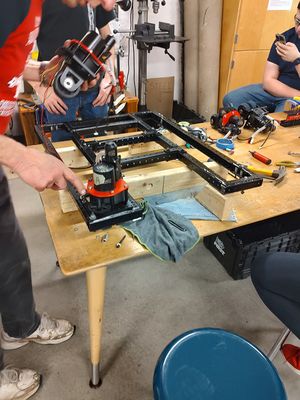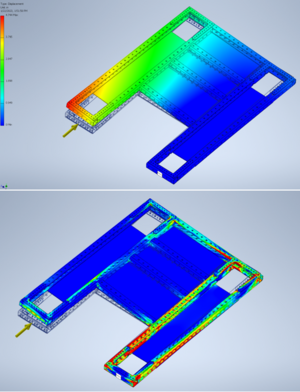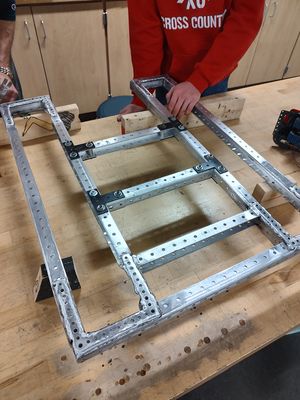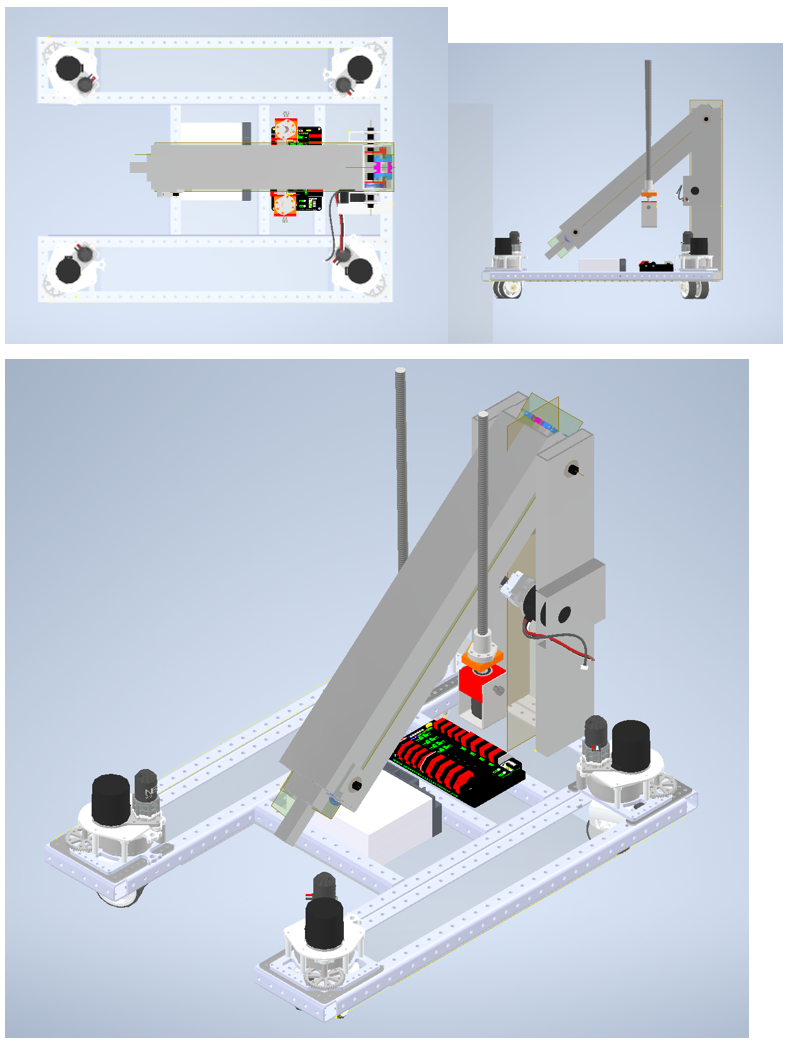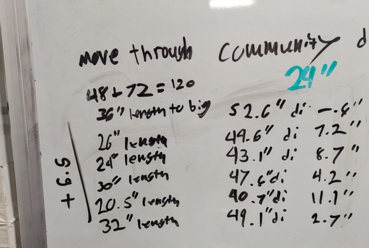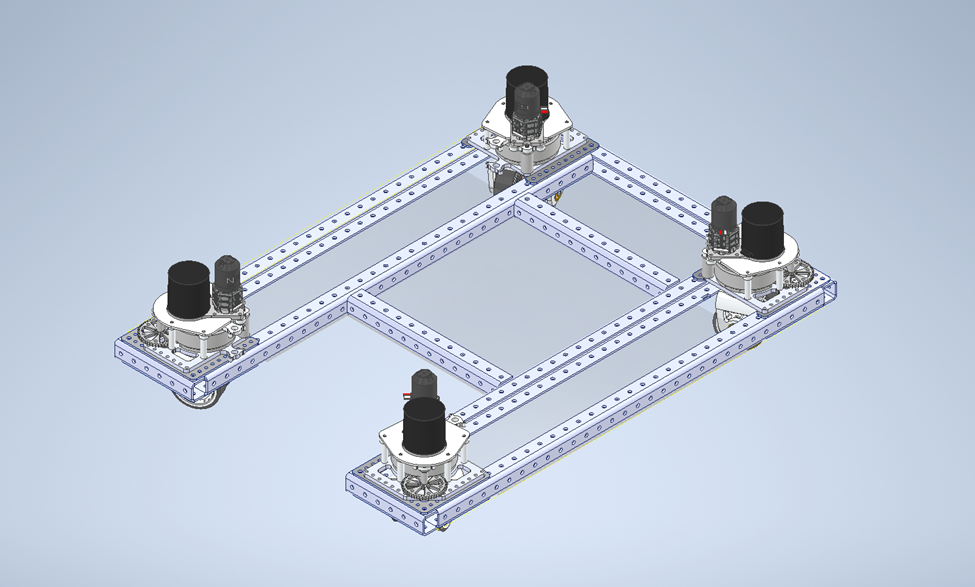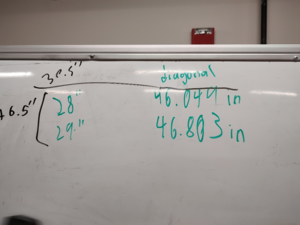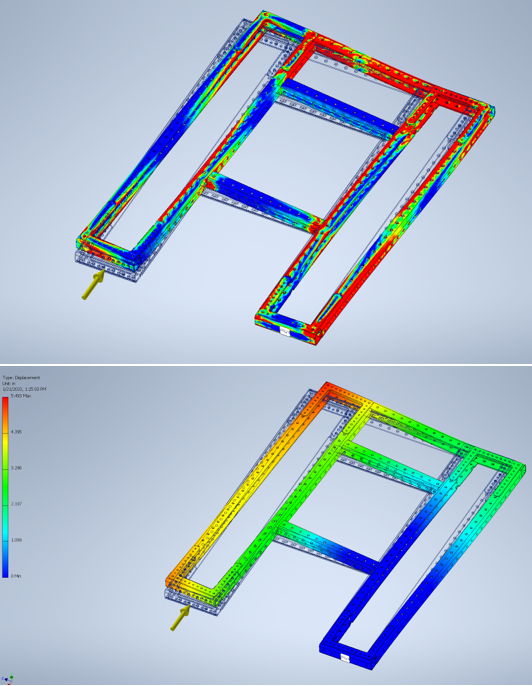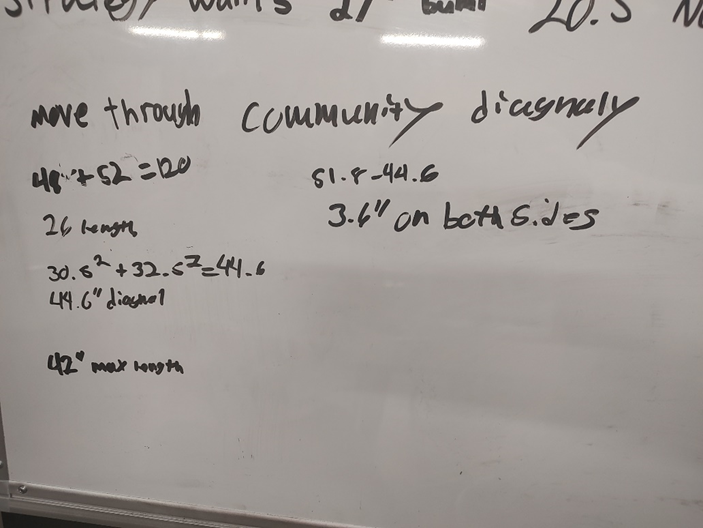2023:Drive Base
Calculations for the drive base perimeter and diagonal distance based on constraints from strategy and various subteam leads. Refer any questions to Nick L. or Berkeley P, class of 2023.
1/15/2023:
Based on our calculations, driver input, subteam and strategy requirements, and mentor approval, we first proposed to use a 26.25 inch by 30.25 inch drive base WITHOUT bumpers, and 32.75 inch by 36.75 inch WITH bumpers. This would allow us to have a diagonal of 49.225 inches, and a minimum extra distance of 6.775 inches while in the shortest part of the community. Additionally, a 12 inch by 10 inch square bumper cutout is necessary for intake.
1/17/2023:
Drive base length has changed to 32.25 inches, at the request of the Lift subteam (They wanted 38 or 36 to feel good, but this would make the robot HUGE). Additionally, we have explored the suggestion to make cutouts in the central C-channel and make the drive base width 2 inches smaller. We have a working CAD of this model, but with a cylinder representing the movement of the swerve modules, and the 2 inches of width removed.
1/19/2023:
We made a final decision on drive base. The frame is 24.25 inches by 32.25 inches without bumpers. There will be cutouts on the inside c-channel to allow the swerve drives to be closer to the inside c-channel. This decision was unanimously voted for at the meeting on 1/19/2023, with both mentor and student approval. We determined that the smaller space would not hinder pit crew in removing the swerve modules if necessary, and that the swerve wheels can rotate freely. Additionally, an FEA analysis of the drive base does not show significant stress on the area where material will be removed for the cutout, and the lead mechanical mentor assured us that it would be structurally stable. This change makes the overall drive base smaller, and brings the diagonal distance to 49.468 inches, leaving us 6.5 inches under our maximum distance of 56 inches.
1/21/2023 (Approximately 5:00pm):
Made the FEA analysis shown in the 4 images. This shows the areas of greatest stress on the drive base, and shows the validation for the cutouts from 1/19's drive base decisions. Additionally, while the first pair of images shows a high amount of stress, the second pair of images has much less stress due to the addition of the Lexan bellypan. We also plan to explore additional diagonal brackets on the sides of the robot to improve stability. While the Lexan design is not finished (Additional lightening and attachment holes are needed), this demonstrates that the drive base will be more stable with these additions. Later today and tommorow we plan to prototype 4 cylinders that extend from the bottom of the drive base to anchor us to the charging station. We will attach these to the bottom of our 2022 robot, and test the design on a mockup charge station.
1/21/2023 (Approx. 8:15 pm):
Tested 4 cylinders on 2022 robot. We found that brick mode did most of the heavy lifting to keep the robot from moving while on flat ground. We tested on a smooth concrete floor.
1/22/2023 (~5:00 pm):
Tested 4 cylinders on the robot while on a ramp, while on Lexan material. This was much more effective, and lifted the robot a few inches off the ground. We have removed 3.25 inches of length from the Lexan bellypan to allow space for this mechanism if necessary.
1/24/2023:
After integration, we put bumper mounts in the CAD based on the bumper mounts on the 2022 robot. We put lightening holes in the bellypan Lexan, and built a mount for the parking brake. After stress testing the parking break mount with FEA and the part made of 0.5 inch aluminum. All four aluminum pieces weight 1.648 lbs
1/25/2023:
Too much snow, no robots :(
1/26/2023:
We have removed the lightening holes from the Lexan, as they only remove about 0.25 lbs. We made a battery box prototype that did not work because it was too big for the robot. We made a nicer battery box that fits and lifts straight out of the robot instead of sliding it out. The battery box is 8.25" x 7.25"
1/28/2023 + 1/29/2023:
Battery box broke, but we fixed it. Many changes were made to battery box height, width, depth, and mounting holes. We plan to mount it on the drive base at each of the four corners, and secure it with a strap. This strap will also serve as a way to lift the battery out of the box. We made a prototype of the parking break, and 3d printed a, "hockey puck" to mount on the bottom. This worked well, and stayed in its shape while under large amounts of force. Shop drawings were made for all drive base parts except those associated with the parking break. Lastly, the U-Brackets finally arrived! The drive base will be welded together and assembled by the next meeting.
1/31/2023:
We received the fully welded drive base!!! We worked on filing down some of the rougher welds, and making sure the screw holes all lined up. Once this was complete, we painted the drive base. In CAD, we worked on updating the parking break, and ordered the necessary parts.
2/1/2023:
Added bumpers to final CAD. Mounted swerve modules onto drive base. Discovered issues with the parking break. We had planned to mount the bumpers at the highest possible height (7.5 inches off the ground) in order to ensure we can climb the charge station. However, this prevents us from using the parking break, as it would technically raise the bumpers and violate R402. Tomorrow, we will discuss three possible solutions: lower the bumpers/make the bumpers 4.5 inches tall, change the cylinder mounts through extensive testing, or scrap the parking brake entirely.
2/2/2023:
After discussing the bumper height issue, we decided to still go forward with the Parking Break and either shave down the spacers on the parking break mount or move the bumpers down by half an inch. The cylinders lift the robot by 0.437 inch, and these solutions should allow us to remove the excess height and still allow the Parking Break to engage with the ground.
2/4/2023:
We continued fabricating the drive base, and started working on the piston mounts. Worked on Lexan panels in CAD to protect the robot.
2/5/2023:
Worked on Lexan panels in CAD to protect the robot.
2/7/2023 - 2/9/2023:
Drive base is almost fully assembled! We have continued to work on parts, and designed the mounting hardware for the Lexan panels after the Lexan designs were finalized. We then began fabricating the superstructure, and worked more on the parking break. Additionally, we finalized the bumper height at 7.0 inches above the ground.
2/11/2023:
After integration, we decided to make the parking brake mounts out of 1/8 inch aluminum instead of 1/2 inch aluminum. This helps reduce weight, without decreasing the strength of the mounts. Additionally, this means we will need two new spacers for the inside of the C-Channel. We made the new parking brake mounts on the CNC, and tested that they fit on the robot.
2/12/2023:
Worked on fabricating and assembling the superstructure mounting hardware. We cut the square tubing, and moved a mounting hole to compensate for the drive base mounting screws.
2/14/2023:
While waiting for the parking brake spacers to 3d print, we worked on mounting the accumulator panel. We discovered that the triangle brackets in the original design did not allow access to the nuts securing it to the drive base. We first attempted to drill larger holes in the original 3d printed parts, but ultimately decided to reprint the parts with larger holes.
2/15/2023:
Through careful drilling, we were able to do a mockup mount for the accumulator panel using the original triangle brackets. Additionally, we have created a 3d printed part to interface with the lock nuts securing the ribs of the superstructure to the drive base. This helps add stability, and prevents the ribs from bending. For further information on drive base assembly between 2/16 and 2/25, see the Drive Base Assembly Instructions file in the Drive Base folder, and in Teams.
2/18/2023:
The parking breaks were mounted and tested on the robot. Pneumatic and code issues were figured out with testing. When the bumpers were on and the pistons were fully extended, the front was half an inch about being legal (8'' instead of 7.5''). The was an issue noticed that the back was lower than the front, potential reasons for this could be robot CG and mounting errors. In addition, the hockey pucks rotated during the testing which is not good. The height issue is planned to be fixed by moving the parking breaks above the frame, electrical will then route under the break. The ribs will be altered a bit with height with this change. The amount of spares drivebase needs has been chosen and will come into effect as the robot progresses.
2/19/2023
Majority of the day was focused on finishing lift and gripper. There is currently a conflict with the gripper beam break sensor mountings and the drivebase swerve motors. Gripper is changing sensor mountings or types in order to remedy this.
